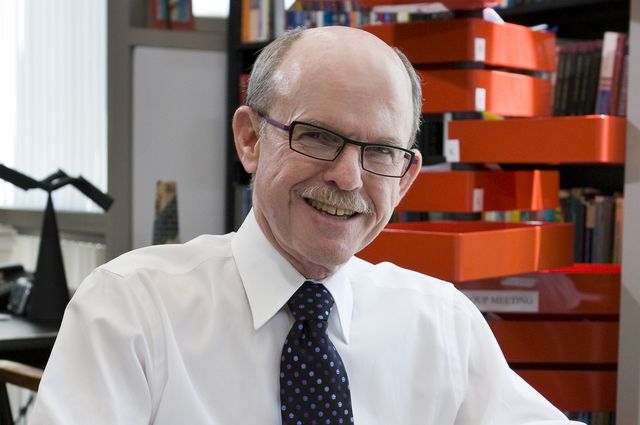By Stuart Wolpert | UCLA Newsroom
Kendall Houk, UCLA’s Saul Winstein Professor of Organic Chemistry, who turned 72 last week, has reached a milestone in his distinguished career: his 1,000th research publication.
“Ken Houk is not only one of the most productive chemists of our times, but he is also one of the most influential,” said Miguel Garcia-Garibay, chair of the UCLA Department of Chemistry and Biochemistry. “He is able to formulate the most complex chemical challenges in terms of elegant reactivity models, and provide not only extremely accurate solutions based on quantum mechanics, but also some of the most intuitive models that an organic chemist can draw on a piece of paper to make meaningful predictions.”
Houk and his research group have been extremely productive, publishing 58 papers in 2014 alone. Paper No. 999, co-authored by UCLA postdoctoral scholars Sílvia Osuna and Gonzalo Jiménez-Osés and graduate student Liz Noey, described their use of molecular dynamics to probe how directed evolution of enzymes leads to better catalysis.
Houk’s 1,000th paper, published in the Journal of the American Chemical Society, described a quantum mechanical and molecular dynamics study of chemical reactions involving tetrazines. These are important chemical reactions with significant applications for the exploration of biology using chemical probes. Houk gives much of the credit to his colleagues, whom he describes as “fantastic.” He conducted the research on this latest publication with a team that included a visiting graduate student from Germany, Lisa Törk; postdoctoral fellow Gonzalo Jiménez-Osés from Spain; longttime collaborator Charles Doubleday from Columbia University; and Fang (Acia) Liu, who received her Ph.D. in computational chemistry from UCLA in 2014.
“All 1,000 papers were the result of my work with superb students and postdocs in my group, and recently about half of my papers have involved collaborations with other great scientists all over the world,” Houk said. “Each paper is special on its own basis.”
Houk has pioneered the use of computer calculations and simulations to study organic chemistry and to predict chemical reactivity. His research group has made predictions of new phenomena that have been verified experimentally, and he has made critical contributions to our understanding of how enzymes are able to selectively catalyze reactions.
He and his colleagues conduct research on computational methods to predict catalysts for reactions that will have important applications in industry and in therapies for fighting disease.
“Our work is theoretical and computational but is always tied to real phenomena,” Houk said. “We first try to understand what is happening and then try to make predictions that experimentalists can test. The goals of our research are to develop a comprehensive theory of chemical reactivity and to use computational methods to design the arrangement of groups inside a protein to cause any desired reaction to occur.”
For more information, visit Houk’s website.

